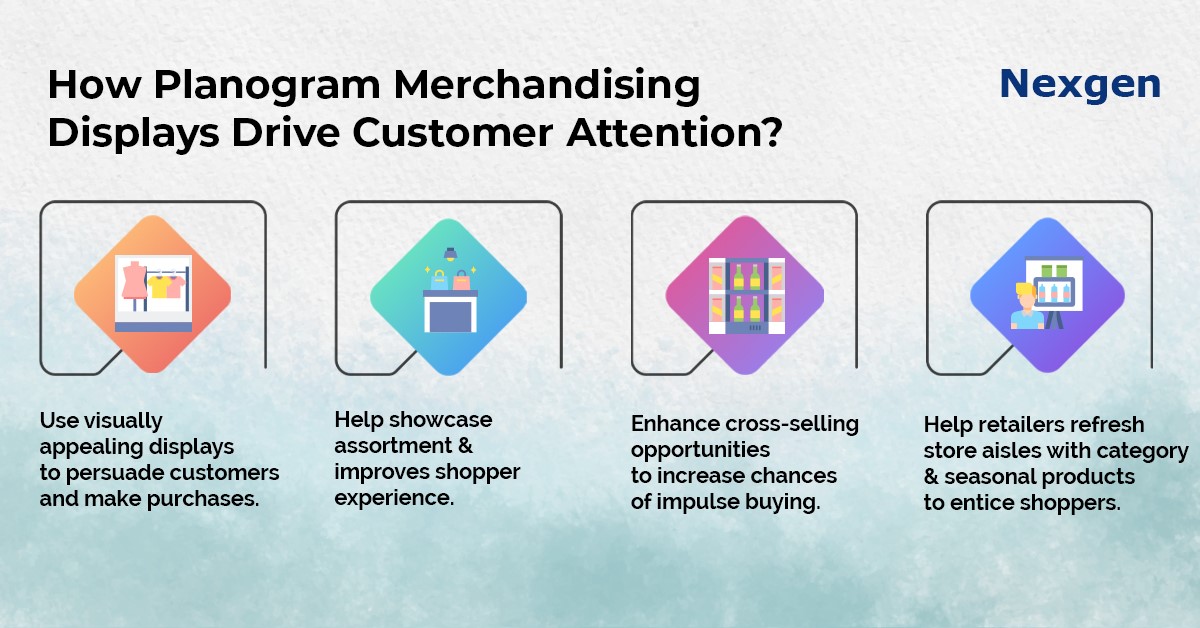The merchandising displays you use in-store can go a long way towards assisting you in meeting your retail goals. Imagine that one of your goals is to improve sales. With the right merchandising display strategy, such as planogram in retail, your shoppers can ensure they find the items they want and when they want them. Planogram merchandising displays are designed to strategically arrange products in a retail space to maximize sales and enhance the customer’s shopping experience. It leads to an increase in sales as most shoppers realize how easy it is to shop at your store. It may also help you improve the overall shopping experience. Your customers will find what they are looking for and keep coming back. If you choose the incorrect display as well as the incorrect method or tactic, you could easily end up squandering both time and money. The following are several ways in which planogram merchandising displays can effectively drive customer attention in your store:

1. Decide on your retail goals.
Before you can determine whether your chosen merchandising displays drive sales or not, you need to choose your goals. That much is obvious. So, as a retailer, what do you want to achieve? Could it be to offer an enticing shopping experience for your customers? Alternatively, you could improve the layout of your store. Or is it to gain better control over your inventory?
Whatever objectives you set; they must fit in with your retail end goal. Improving profitability might be a primary goal for most retailers. However, there is more to growing your retail store than increasing profits. For example, you want to offer items that are priced higher, or, let us say, you want to differentiate yourself from your competitors. In both situations, you must ensure your merchandising displays are placed in such a way that you can achieve these goals. Once you have chosen your goals, it is crucial to match them to a category role to organize products into logical product groups, making it easier for customers to find what they are looking for. Well-structured displays with clear signage and categorization create a more efficient shopping experience, guiding customers to the desired product categories and enhancing their overall satisfaction.
2. Match your goals to how you merchandise your items.
As we discussed above, proper category management can help you understand shopper’s behavior towards different product categories in your store. Let us say, if a shopper visits your store looking for a particular product, for example, croissants, you can cross-merchandise complementary items like cupcakes or pastries nearby. Likewise, place a display at the end of a trafficked aisle with signages like ‘buy one, get one free’ or ‘3 for 2 deal.’ If you have recently restocked your store with beach items – a common summer product category, displaying them with a summer themed layout can create a sense of urgency and excitement, prompting customers to pay closer attention to featured products or limited time offers.
3. Analyze your retail data to identify if you have chosen correctly.
It is always good to understand your retail data to identify the key indicators that are most relevant to your chosen merchandising strategy. This will help you understand how much space is occupied by each product category, the number of units, its placement, and more. Once you gather the data, you will know if you have met your targets. For example, if you sell skin care products, you can analyze your past sales data to understand what type of categories have high sales. It could be serums, moisturizers, body lotions, or eye creams. You can evaluate the sales data for each category and identify its performance over a specific period, such as 3 to 6 months. When merchandising the products on your planogram consider these factors to provide the right shelf space for the items to boost sales.
Overview of Nexgen POG
Nexgen POG is a robust and user-friendly cloud-based visual merchandising tool. It is designed for quick and efficient planogramming with minimal effort. Planogram in retail can be designed by easily dragging and dropping the products. The multi-device compatibility feature of POG allows you to obtain, share and edit planogram on any device, including your phone. It helps in designing store-specific planograms for increased product visibility and sales.
Get Your Free Trial Now!